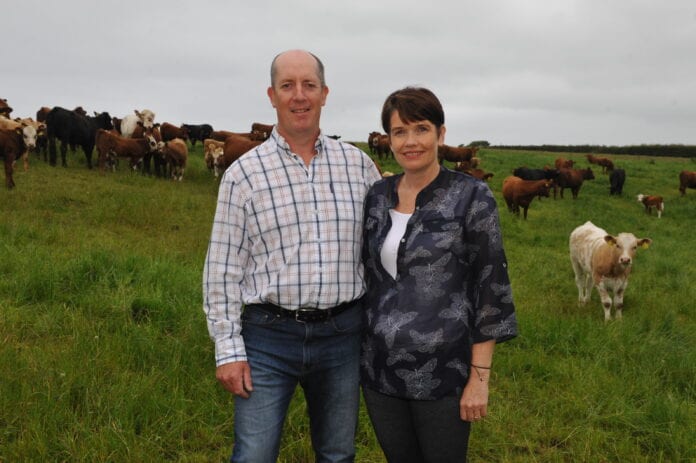Growing herbal leys is helping a Welsh suckler beef farm grow and finish cattle at pasture while reducing its nitrogen use.
Huw and Meinir Jones grow 6.5 hectares (ha) of a seed mix incorporating deep rooting plantain and chicory and nitrogen-fixing clover at Bryn Farm, a Farming Connect demonstration site near Cardigan.
During a recent Farming Connect webinar, they said they had opted to include ryegrass in a mix rich in minerals to improve the longevity of the ley.
“If the chicory and plantain fade out after four or five years we will still have clover and ryegrass,” said Mr Jones.
The herbal ley was first grazed with lambs at the beginning of August 2020, with the field split into five paddocks to prevent selective grazing.
After being left to rest since December, it measured 2,400kgDM/ha when store cattle were turned onto it in mid-March. No fertiliser has been applied.
The target growth rates for the growing cattle on the herbal leys are 1.25kg/day over the grazing season; they will be weighed twice over the summer to track progress.
Dr Liz Genever, an independent beef and sheep specialist, who has been advising the Jones’ with their Farming Connect project work, said one of the most important considerations for growing herbal leys is their management in wet conditions.
“They don’t like to be grazed in wet conditions so careful management is needed, for instance grazing with lighter animals to avoid persistency issues,” she said.
They perform well in a rotation but for farms with heavier, clay soils, a mix of clover and grass, timothy or fescues in particular, might be preferable, Dr Genever added.
Bryn Farm is a dry farm so for the Jones’ the herbal leys can provide them with grazing even when conditions are very dry.
They are now considering nearly doubling the acreage, to 10ha, to provide a grazing block for growing cattle.
They produce beef from 80 sucklers which are sired to a Charolais or Saler and calve from 3 February.
The farm has been rotationally grazed in a 0.4 ha (1 acre) paddock system for three years – in mid-season the rotation averages 28 days.
“We are much more in control with smaller paddocks, we are seeing great progress with grass utilisation and grass growing back after it has been grazed,” said Mr Jones.
“We do need to be flexible though, the cattle tell us what they need.”
Mrs Jones measures the grass with a plate meter and the data is uploaded to Agrinet to inform the grazing plan. The farm’s grass growth is monitored by the Welsh Pasture Project and data can be seen on the Farming Connect website.
A group of 67 cattle are grazing the 0.4ha blocks and with a requirement of 15kgDM/day/head this creates a total daily requirement of 1,005kgDM. In mid-March the farm had an average cover of 2,378kgDM/ha which means the covers in the 0.4ha blocks are matching the daily demand of the group.
Mr Jones said he is now much more confident with turning cattle into lighter covers.
“Before we wouldn’t graze until the covers were around 3,000kgDM ha but we have come to learn that a short, sharp shock of grazing at lower covers and moving the cattle on will have the grass growing back.”
It is good for calf health too, said Mrs Jones.
“The cows had too much milk when we were grazing heavier covers and that was causing issues with the calves,” she said.
The Jones’ are now considering revising the calving start date to the end of February, to better suit grass growth.
“It would mean that I could keep the store cattle in the shed for longer and they could go straight out to graze the herbal leys,” said Mr Jones.
Currently over 90% of the herd calves in a seven-week period.
In 2021, the plan is to reduce the bulling period to six weeks; advantage will be taken of the slight delay in introducing the bulls this year with the calving start date being moved to late February.
Farming Connect, which is delivered by Menter a Busnes and Lantra, has received funding through the Welsh Government Rural Communities – Rural Development Programme 2014-2020, which is funded by the European Agricultural Fund for Rural Development and the Welsh Government.
Help keep news FREE for our readers
Supporting your local community newspaper/online news outlet is crucial now more than ever. If you believe in independent journalism, then consider making a valuable contribution by making a one-time or monthly donation. We operate in rural areas where providing unbiased news can be challenging. Read More About Supporting The West Wales Chronicle





















